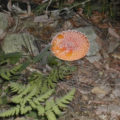
The fresh fruits and vegetables section of a standard American supermarket looks much the same all year round. There is no seasonal variance in the availability of any common foodstuff: you see the same tomatoes, lettuce, broccoli etc., even when they have to be imported from someplace far away where the weather is right for growing them. This everyday "luxury" is so ingrained into American habits that, when I first moved to Italy, it never occurred to me that certain items might simply not be available at some times of year. "What do you mean, it’s not the season?"
Italian fruttivendoli (greengrocers) and their customers favor the fruits and vegetables of the season. You can certainly buy, e.g., greenhouse strawberries in winter, but they’re much more expensive, and not nearly as tasty, as the ones grown outdoors in their proper time. The most flavorful foods are grown "locally" and are bought at the peak of their season, when, due to their abundance, they’re also cheapest.
Right now it’s winter and we’re flooded with agrumi (citrus) from Sicily and other southern parts of Italy (and Spain). You can get some sort of oranges (arance [ah-RAHN-chay]) all year round, but at this time of year they’re huge and juicy, a colorful antidote to the gray weather. Blood oranges – my favorites – don’t look much different from any other kind on the outside, but inside: red red red! Squeeze them to obtain a thick, syrupy juice that looks like a vampire’s breakfast.

even the packing is gorgeous! – blood oranges
My favorite citrus, however, are clementines. I guess these are what Americans call tangerines: smaller than oranges, when ripe they are loose in their skins and easy to peel. They break apart neatly into bite-sized sections that you can pop into your mouth and enjoy a squirt of juicy sweetness, without getting it all over your hands and face. Actually, clementine [cleh-men-TEEN-ay] are usually so small that you can eat half of one in a single mouthful.
These (along with Glucose biscuits) were my favorite winter travelling food in India, and are just as handy on Italian trains: I can pop a few into my backpack, peel and eat at will. If they get a little mushed, it’s no matter – a section or two may be squished, but they don’t turn black like bananas, and the rest is perfectly edible. I also keep some on my desk for mid-morning and mid-afternoon snacks. A golden pyramid of clementine offered to guests after dinner will disappear entirely as people talk and nibble, easily downing five or six each.
There are several varieties. There are clementine con o senza semi (with or without seeds), pictured at top. There are mandarini, which are tiny, with a smooth, shiny skin that fits tightly and can be difficult to peel. There are mandaranci, which I take (from the name) to be a hybrid of oranges and mandarins. There’s a larger variety of clementine which is closer to what I remember from India – not as sweet and juicy as the standard Italian version.
I don’t buy late-season fruit: it’s always disappointing after the wonders of a fine fruit at the height of its glory. I’ll enjoy the clementine while they last. Then they will slowly disappear from the shops, and we’ll have to survive on pears and apples until the early summer fruits (cherries!) start coming in.
photos shot at Il Fruttorto, Lecco




